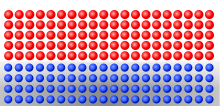
Frank–Van der Merwe growth (FM growth) is one of the three primary modes by which thin films grow epitaxially at a crystal surface or interface. It is also known as 'layer-by-layer growth'. It is considered an ideal growth model, requiring perfect lattice matching between the substrate and the layer growing on to it, and it is usually limited to homoepitaxy. For FM growth to occur, the atoms that are to be deposited should be more attracted to the substrate than to each other, which is in contrast to the layer-plus-island growth model. FM growth is the preferred growth model for producing smooth films.
It was first described by South African physicist Jan van der Merwe and British physicist Frederick Charles Frank in a series of four papers based on Van der Merwe's PhD research between 1947 and 1949.
See also
References
- Cor Claeys; Eddy Simoen (29 December 2008). Extended Defects in Germanium: Fundamental and Technological Aspects. Springer Science & Business Media. p. 158. ISBN 978-3-540-85614-6.
- John Venables (31 August 2000). Introduction to Surface and Thin Film Processes. Cambridge University Press. p. 146. ISBN 978-0-521-78500-6.
- Matthias Wuttig; X. Liu (17 November 2004). Ultrathin Metal Films: Magnetic and Structural Properties. Springer Science & Business Media. p. 6. ISBN 978-3-540-58359-2.
- "Journal of Materials Research: Volume 32 - Focus Issue: Jan van der Merwe: Epitaxy and the Computer Age | Cambridge Core". Cambridge Core. Retrieved 2018-01-24.
| [REDACTED] | This physics-related article is a stub. You can help Misplaced Pages by expanding it. |